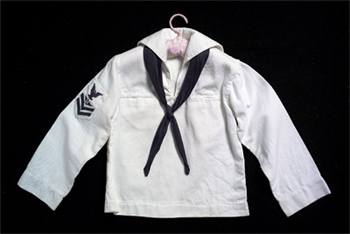 |
| Charles LeDray (American, born 1960), Untitled (Sailor), 1993, fabric on hanger, 31x31 cm, Sarah G. Garver Fund, 2003.155. |
Through October 10, 2004
 |
| Click on thumbnail for larger image. |
At a time when the world is being reconfigured digitally and our lives are structured by daily encounters with virtual reality, this exhibition offers us an opportunity to indulge in the “thingness” of sculpture. Thinking about “how sculptors see,” we are reminded of the degrees of translation involved from idea to object, from obvious beginnings to wondrous results.
When we look at sculpture, we are confronted with the “hard facts” of the physical thing encountered, as well as the real time and space where the encounter between you and “it” takes place. However, this obviousness is but an initial step in seeing. These works, drawn primarily from the Museum's collection, are never only what they first seem to be. Rather, they depend on the possibility of one thing being taken for another-Jackie Ferrara gives us both stacked lengths of pine and architectural sprawl; Nancy Graves' casts of plant life become a gravity-defying arabesque; Heide Fasnacht joins bits of clay and hardware into a “manageable” Milky Way; Tony Feher clusters plastic bottles into a shimmering “invisible” column.
Other times, as the prints and drawings on view show us, sculptural ideas are manifest in two dimensions. Sol LeWitt demonstrates in watercolor how a simple cube evolves into a complex polygon. Christo imagines a wrapped tower in Times Square as monumental sculpture. Rachel Whiteread muses on the absence of form in her series, Demolished. Richard Serra pushes etching into a physical as well as visual experience.
The translation of an idea, image, or material into a sculpture, entails a delicate and complex balance between representation and invention, between what already exists in the world and what an artist brings into the world. Eventually, the process involves us, too, because the gap that exists between where a sculptor's work begins as one “thing” and ends up as another-an intangible yet critical conceptual space-is waiting to be filled with our subjectivity. While these sculptors look to the object with different sets of interests in mind, their works subtly put pressure on what we think we know. They invite us to re-imagine the world with them and to see that there is potential for enchantment in the things around us.
The project features two generations of sculptors including Richard Artschwager, Claire Barclay, Christo, Willie Cole, Tony Feher, Jackie Ferrara, Heide Fasnacht, Nancy Graves, Donald Judd, Jim Lambie, Charles LeDray, Sol LeWitt, Fred Sandback, Richard Serra, Kiki Smith, Ruth Vollmer, and Rachel Whiteread.
This project is supported by the Don and Mary Melville Contemporary Art Fund. Additional generous support provided by Worcester Magazine.


 Sign up for WAM eNews
Sign up for WAM eNews